Photo Tour: ITMO University Optics Museum
Last time we had a tour of the laboratory of optoelectronic devices. The Museum of Optics at ITMO University - its exhibits and installations are the subject of today's story.
Note: under the cut a lot of photos.

')
The Museum of Optics is the first interactive museum on the basis of ITMO University . It is located in a building on Vasilyevsky Island, where the State Optical Institute was previously located. The history of the museum dates back to 2007, when there was a restoration of buildings on the Exchange Line. Before the staff of the university there was a question: what to place in the premises on the first floors.
At that time, the direction of edutainment was developing and Sergey Stafeev , a professor of the Faculty of Physics and Technology, suggested that the rector Vladimir Vasilyev create an exhibition that would show the children that optics are interesting. Initially, the museum helped the University to solve the issue of vocational guidance and attracted students to specialized faculties. At first, only group excursions were arranged by appointment, mainly for grades 8-11.
Later, the museum team decided to organize a large popular science exhibition Magic of Light for everyone. It was first opened in 2015 on an area of more than a thousand square meters. meters
The first part of the exhibition introduces visitors to the history of optics and talks about the development of modern holographic technologies. Holography is a technology that allows to reproduce three-dimensional images of various objects. At the exhibition you can watch a short informative film about the physical essence of the phenomenon.
The first thing that visitors see is the two tables on which the layouts of the hologram recording scheme are located. As examples, a miniature of the monument to Peter I on a horse and a nested doll are chosen.

With a green laser - a classic recording of Leith and Upatnieks , with which scientists obtained the first transmissive volume hologram in 1962.
With a red laser - the scheme of the Russian scientist Yuriy Nikolaevich Denisyuk. No laser is required to view such holograms. They are visible in the usual white light. The holographic part is devoted to a significant part of the exhibition. After all, it was in this building that Yu. N. Denisyuk made his discovery and assembled his first installation for recording holograms.

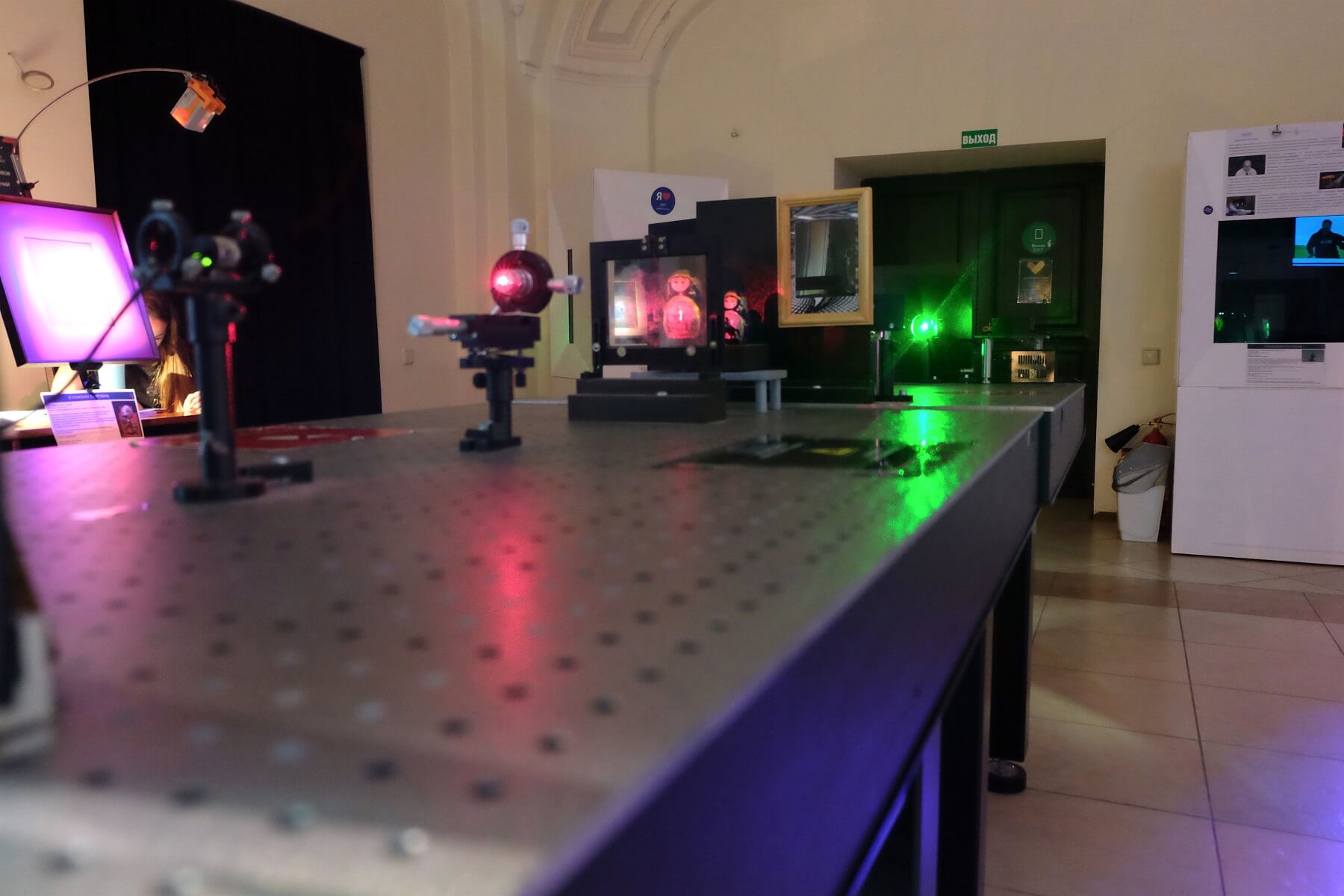
Today, the Denisyuk scheme is used throughout the world. With its help, analog holograms are recorded that are indistinguishable from real objects - “opto-clones”. Boxes with holograms of the famous Easter eggs of Carl Faberge and the treasures of the Diamond Fund are installed in the first hall of the museum.
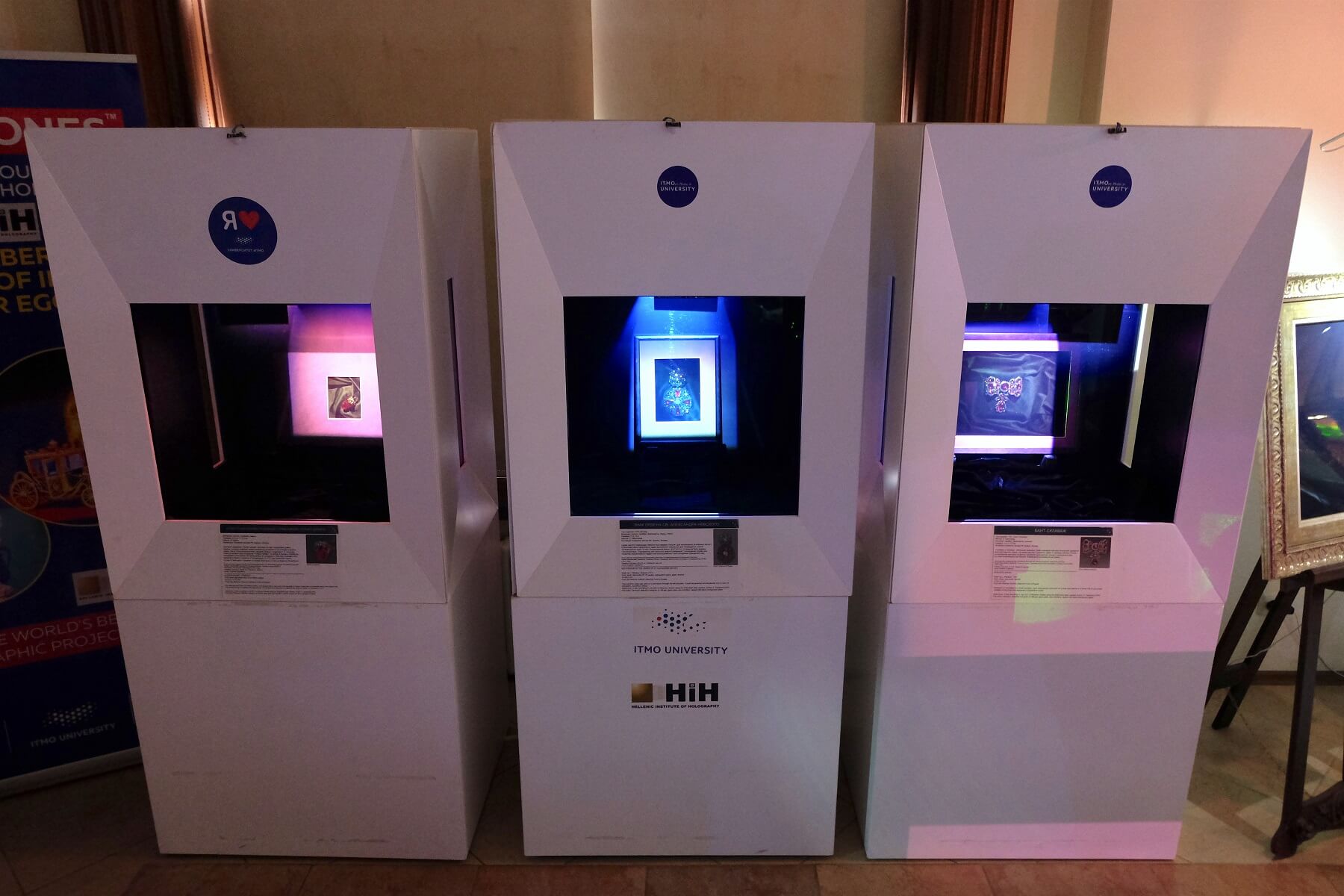
In the photo: holographic copies of “ Ruby Caesar ”, “ Sign of the Order of Saint. Alexander Nevsky "and decoration" Bow-Square "
In addition to analog, in our museum there are digital holograms. They are created using 3D-modeling and laser technology. From a photograph of an object or video (which can be taken with the help of drones) on a computer, its model is being worked out. Then, it is recalculated into the interference pattern and transferred to the polymer film using a laser.
Such holograms are printed with the help of special holoprinters using lasers of blue, red and green colors (there is a little about their work in this short video ).
Still digital holograms are four-angle - they consist of four different pictures. If you go around such a hologram around, the images will begin to change.
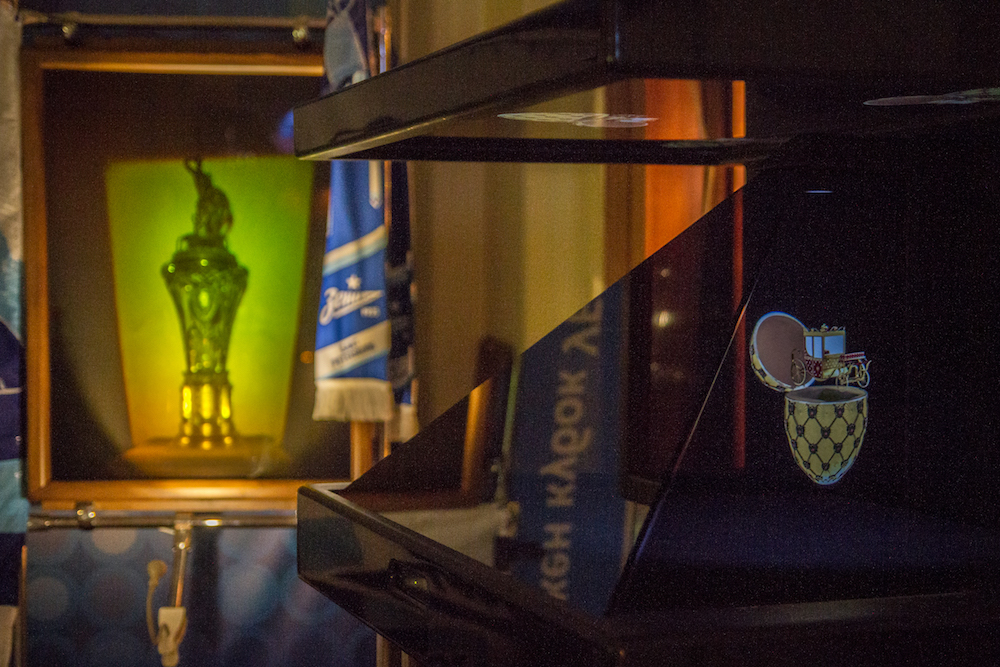
So far, this method of recording holograms has not found wide application because of the cost of equipment for printing. There are no holo printers in Russia, so our Museum contains holograms of American and Latvian origin, for example, the map of Mount Athos.

Photo: Map of Mount Athos.
The second hall of the museum is also partially devoted to holography. Its general view is in the photo below.
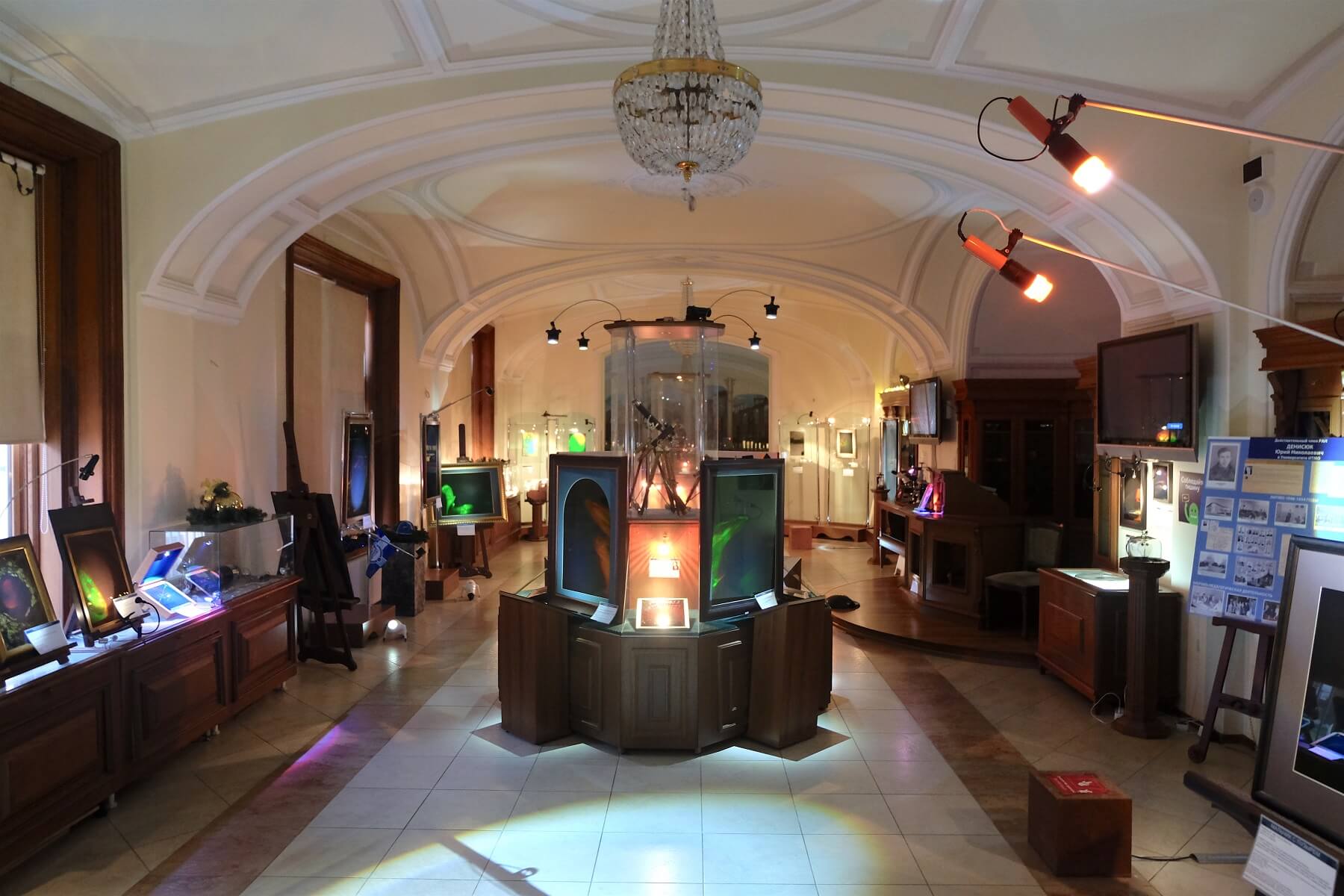
In the photo: Hall with holograms
In this hall is presented the “holographic portrait” of Alexander Sergeevich Pushkin. This is one of the largest holograms on glass, and in scale it is the leader among analog holograms.
There is also a stand with a holographic portrait of Yu.N. Denisyuk with a story about the life of a scientist and his discovery. There is a hologram with footage of the poster for the film “I-Legend”.
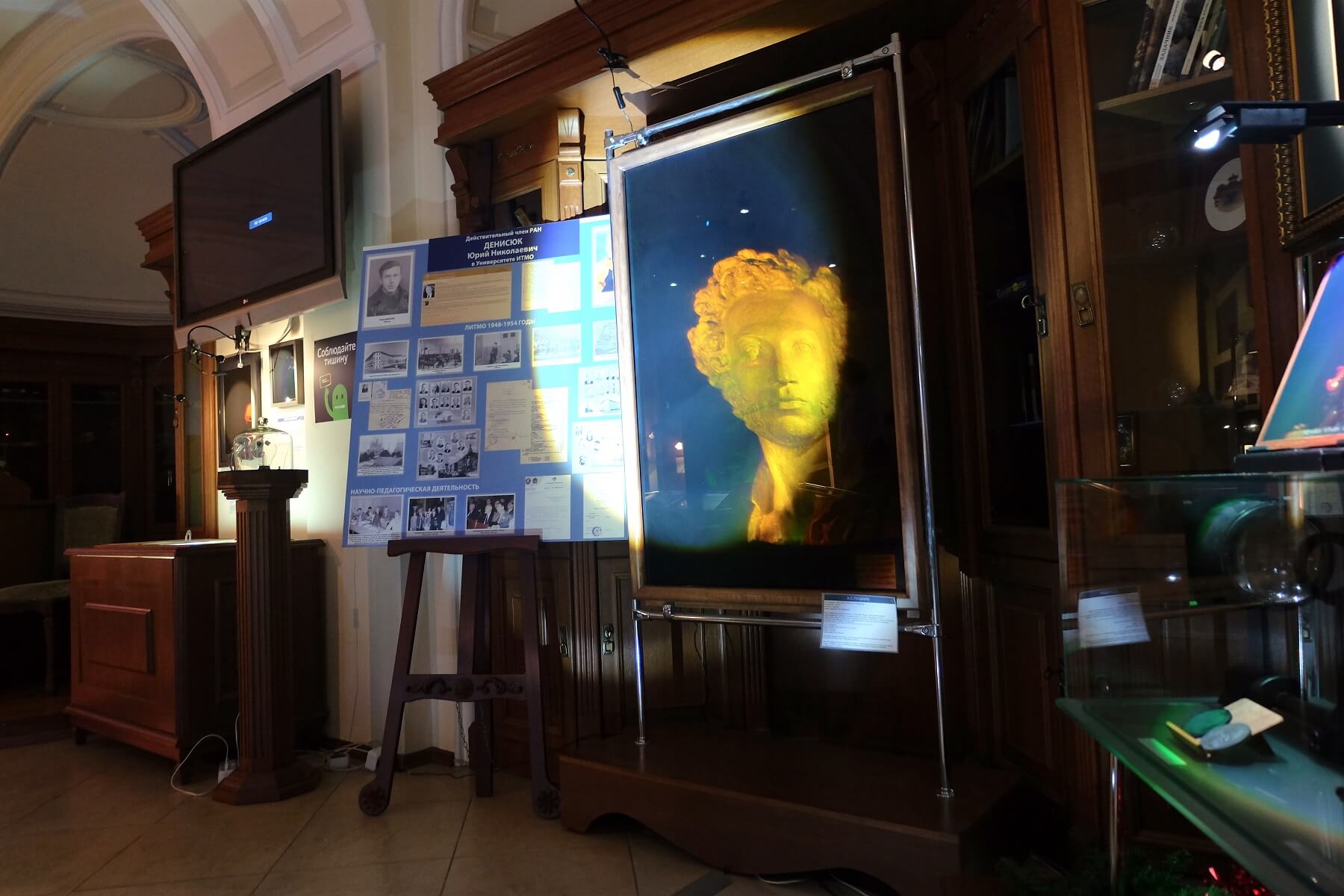
Holograms of objects from various museums of the world, for example Hotei from the Russian Museum of Ethnography, are installed in this hall.

To the left of Pushkin's bust there is a lamp placed in a transparent case. Although the lamp this exhibit seems only at first glance. Inside it is an impeller with white and black blades. If you turn on the spotlight and shine on the impeller, it will begin to rotate.
The exhibit is called the Croix Radiometer.

Each of the four blades has a dark and light side. Dark - heats up more than light (due to the nature of light absorption). Therefore, the molecules of the gas in the flask, bounce off the dark side of the blade with greater speed than from the light. Because of this, the blade, turned to the light source by the dark side, receives a greater impetus.
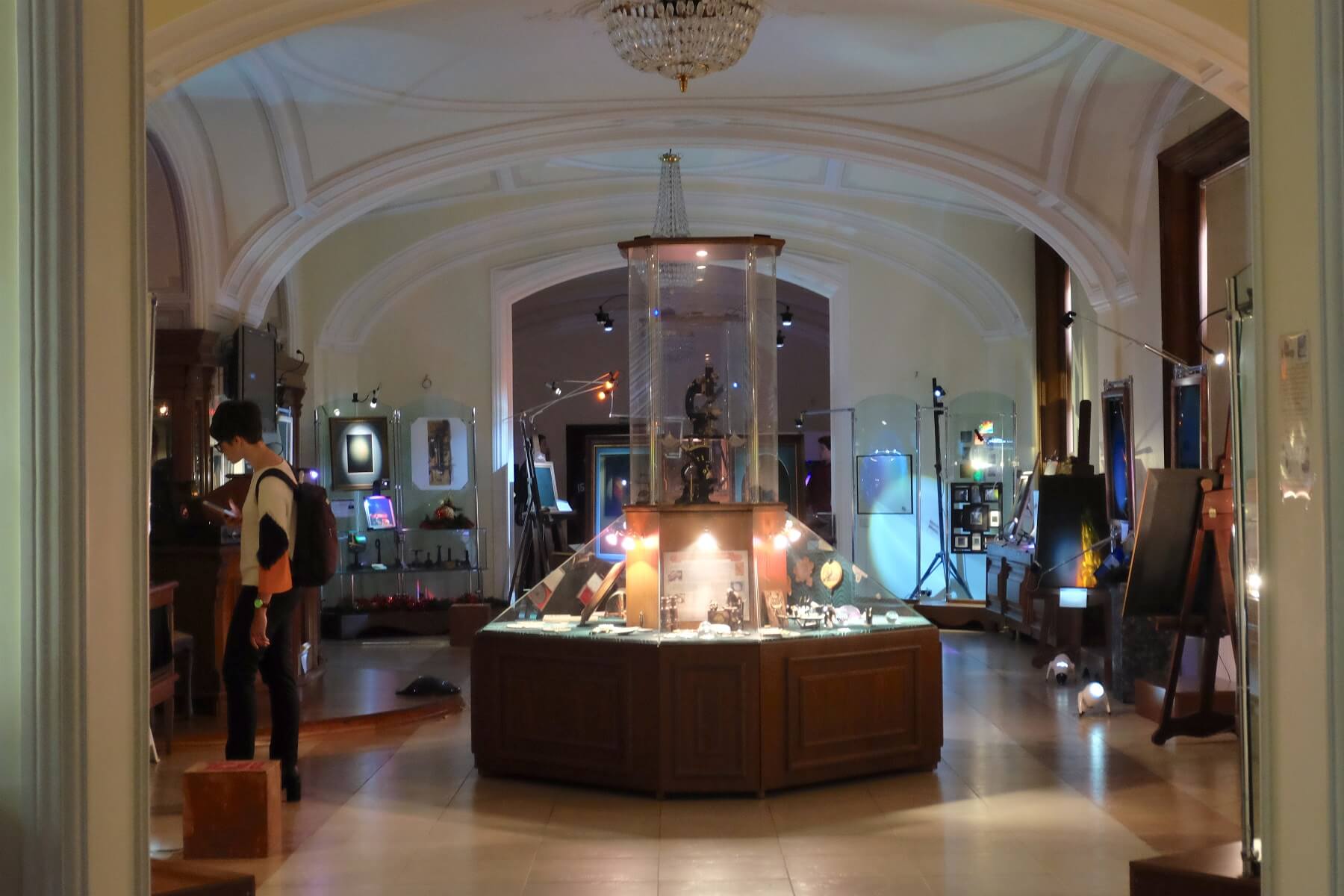
On the stands you can find a large variety of optical devices: microscopes, " reading stones ", vintage cameras and vintage glasses. During the tour you can find out the history of the appearance of the first obsidian mirrors, bronze and, finally, glass. In the showcase presents the present Venetian convex mirror, created by the technology of the XVII century. And the bronze “magic mirror” (if you direct it to the sun, and the reflected “bunny” to the white wall, then an image will appear on it from the back side of the mirror).
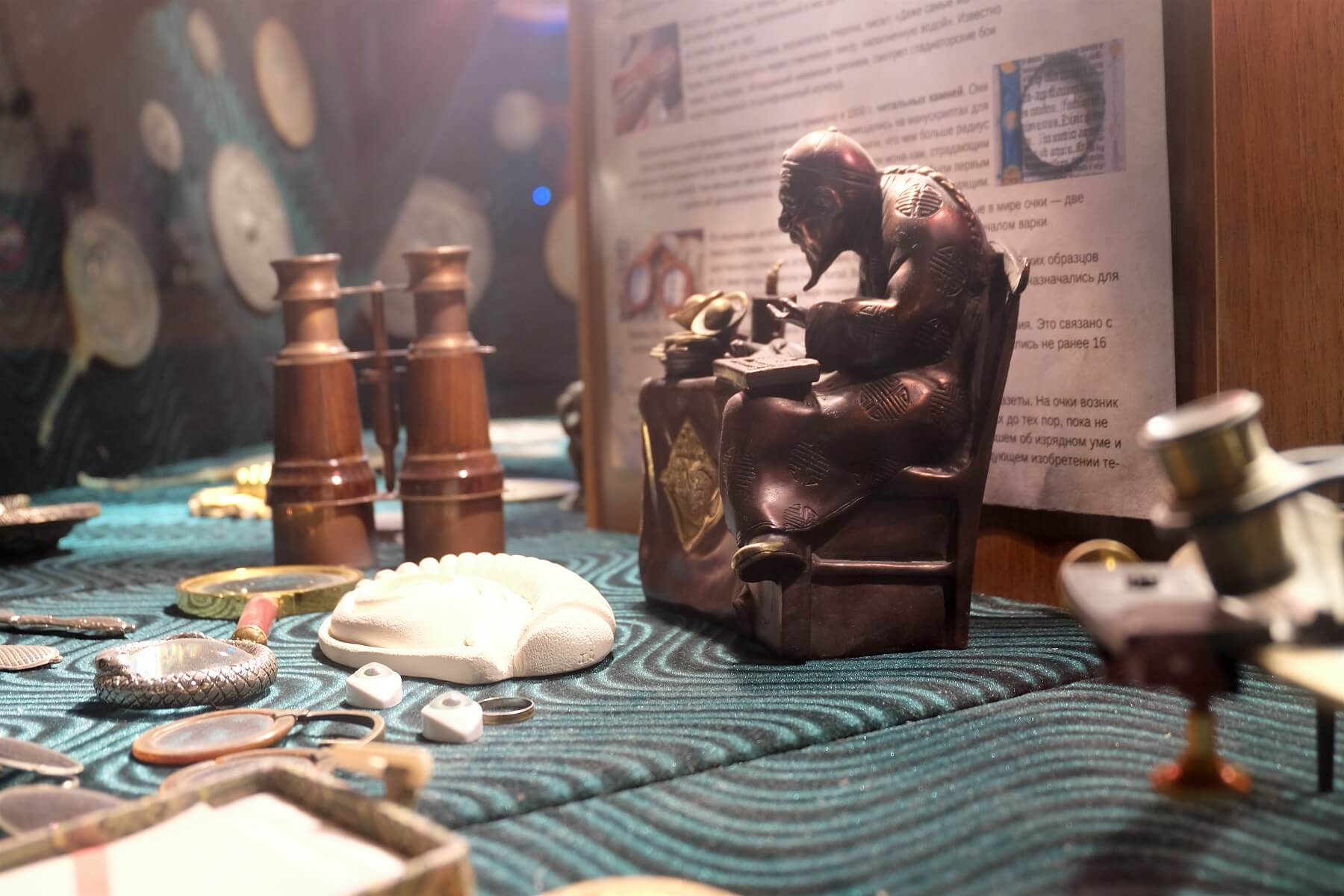
In the same room is a collection of cameras. The exposition makes it possible to follow their development from the camera obscura - the progenitor of the camera - to the present.
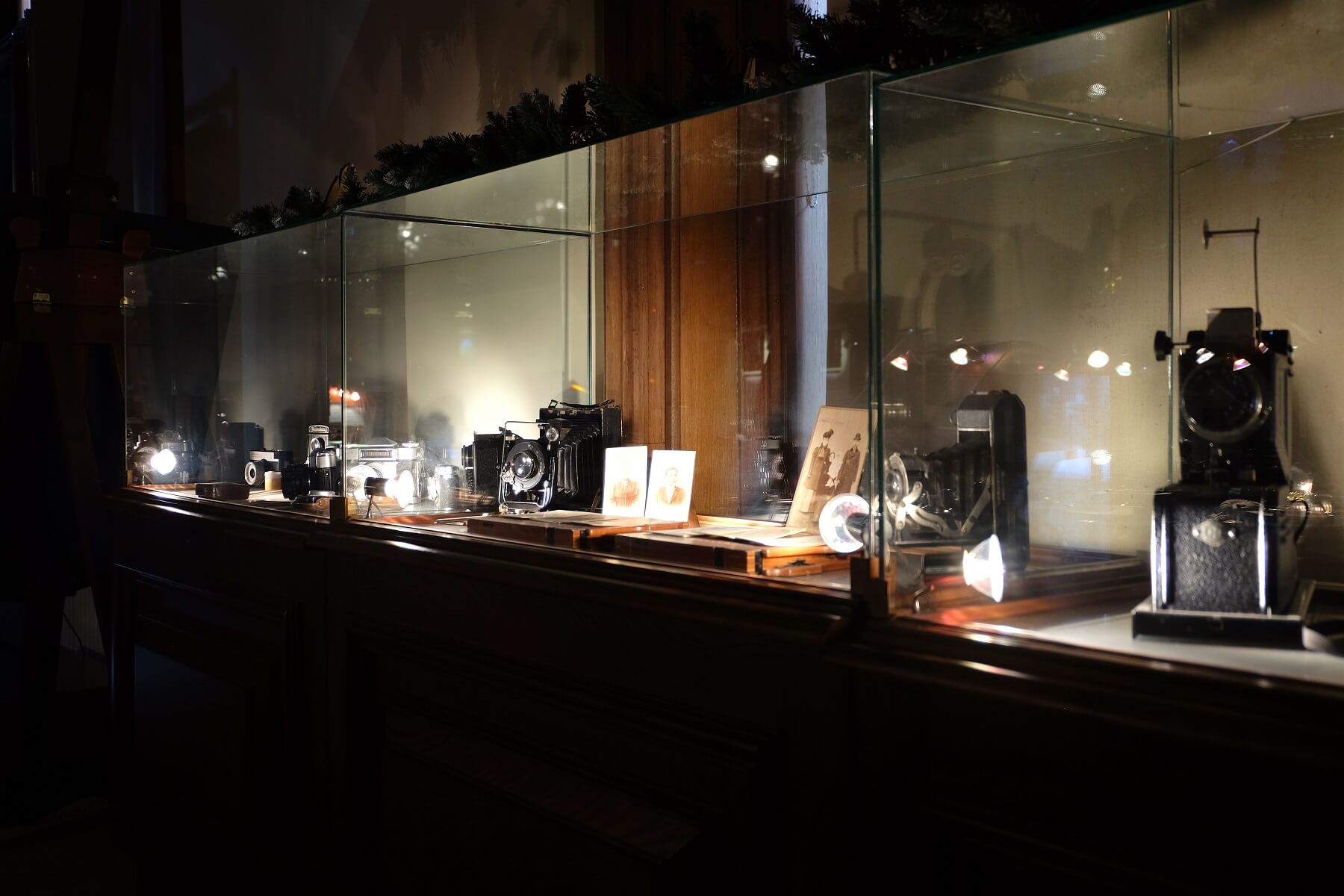
In the photo: a collection of cameras
On the windows were placed cameras with folding fur and copies of the Pontiac MFAP, produced from 1941 to 1948, and AGFA BILLY from 1928. Among the presented devices one can find “ Fotokor ” - the first Soviet high-volume camera, created on the basis of the most successful Western samples. In the USSR, it was produced until 1941.
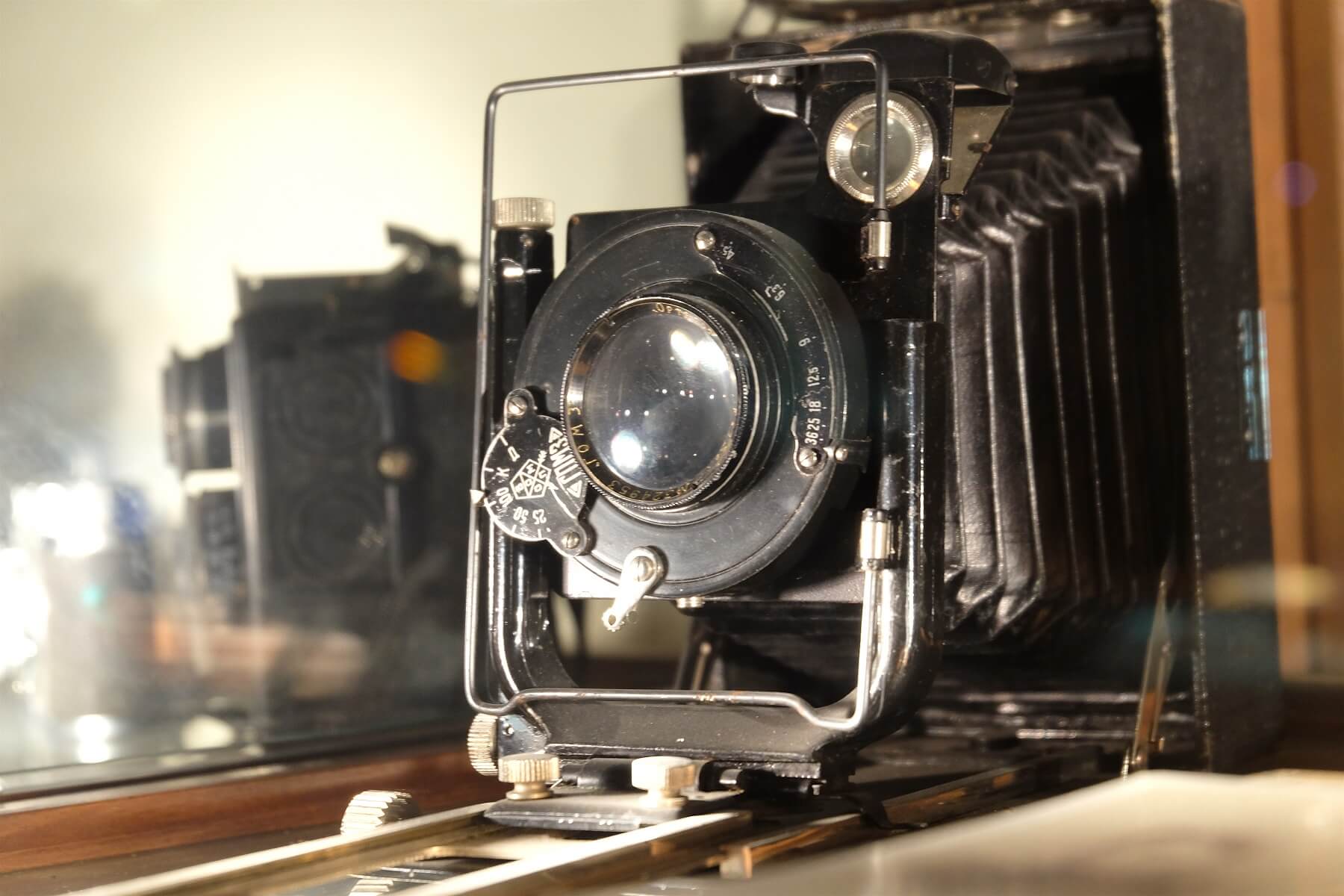
In the photo: Foldable camera " Fotokor "
If you go to the next hall of the museum, you can see a monumental light organ in it. The “tool” consists of 144 special optical glasses of different grades and brands - the Abbe catalog . There is no collection of similar size in the glass blocks and completeness of the collection anywhere in the world. She began to collect in the USSR, in order to perpetuate the achievement of scientists of the State Optical Institute, who developed the technology of production of radiation-resistant glass.
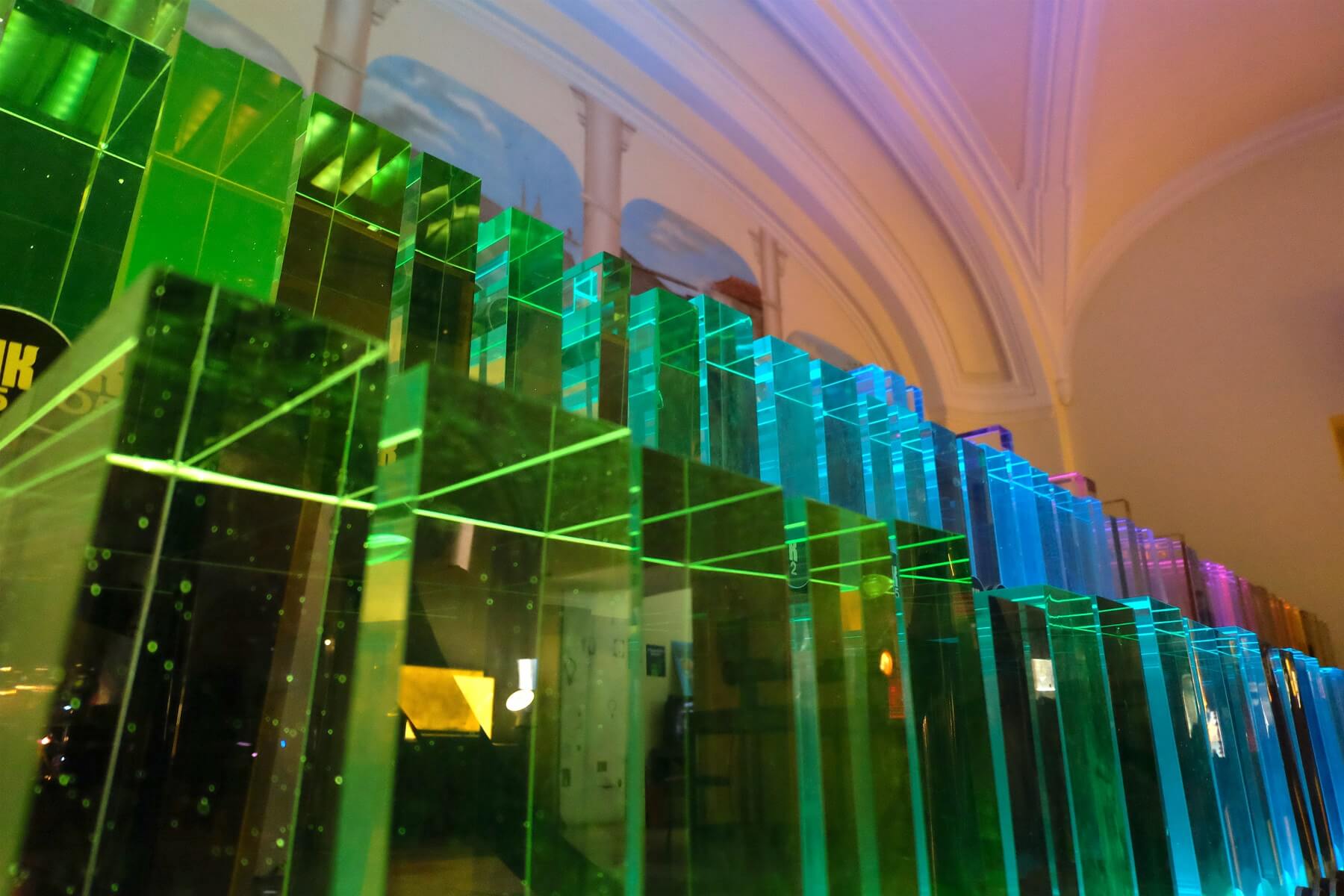
Now under each bar of glass is a LED ruler. These lines are controlled by controllers and a hub connected to a personal computer. If you play a melody on a PC, the organ will begin to flicker in different colors depending on the tone and pitch. The program has eight algorithms for converting sound to color. You can rate the system in this video on YouTube .
After the collection of optical glass should be the second part of the exposure - interactive. Most of the exhibits here can and should be touched. The interactive part begins with a study of the history of cinema and 3D-vision.
Zootropes , phenakisciscopes , phonotropes give an idea of how scientists studied the mechanisms of vision and information processing. You can see an example of a phonotorop in the photo below. The principle of operation is based on the inertia of vision. What we do not see with the eye, as the picture is smeared, is clearly visible through the camera of the smartphone.
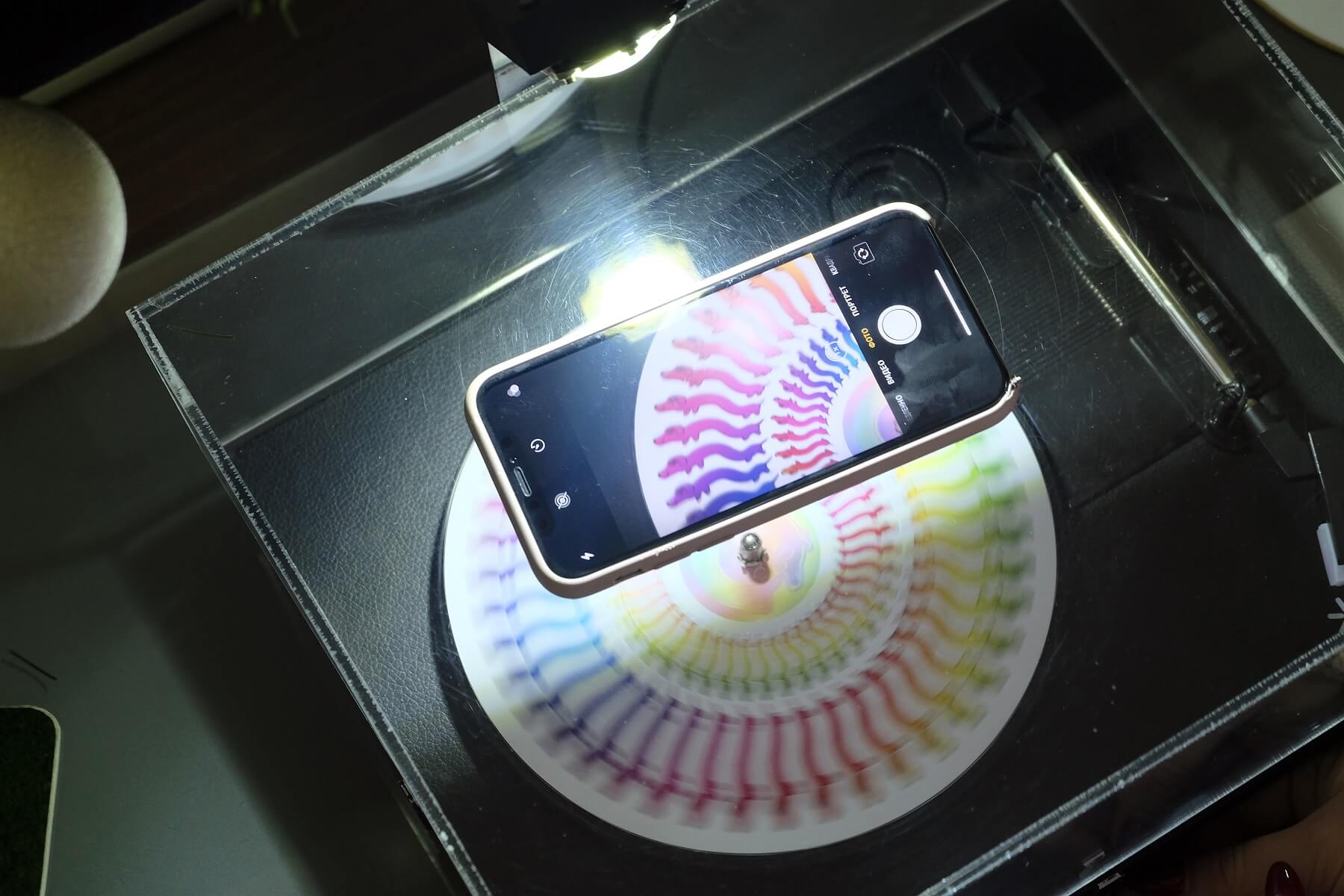
In the photo: phonotrope - a modern analogue of zootrop
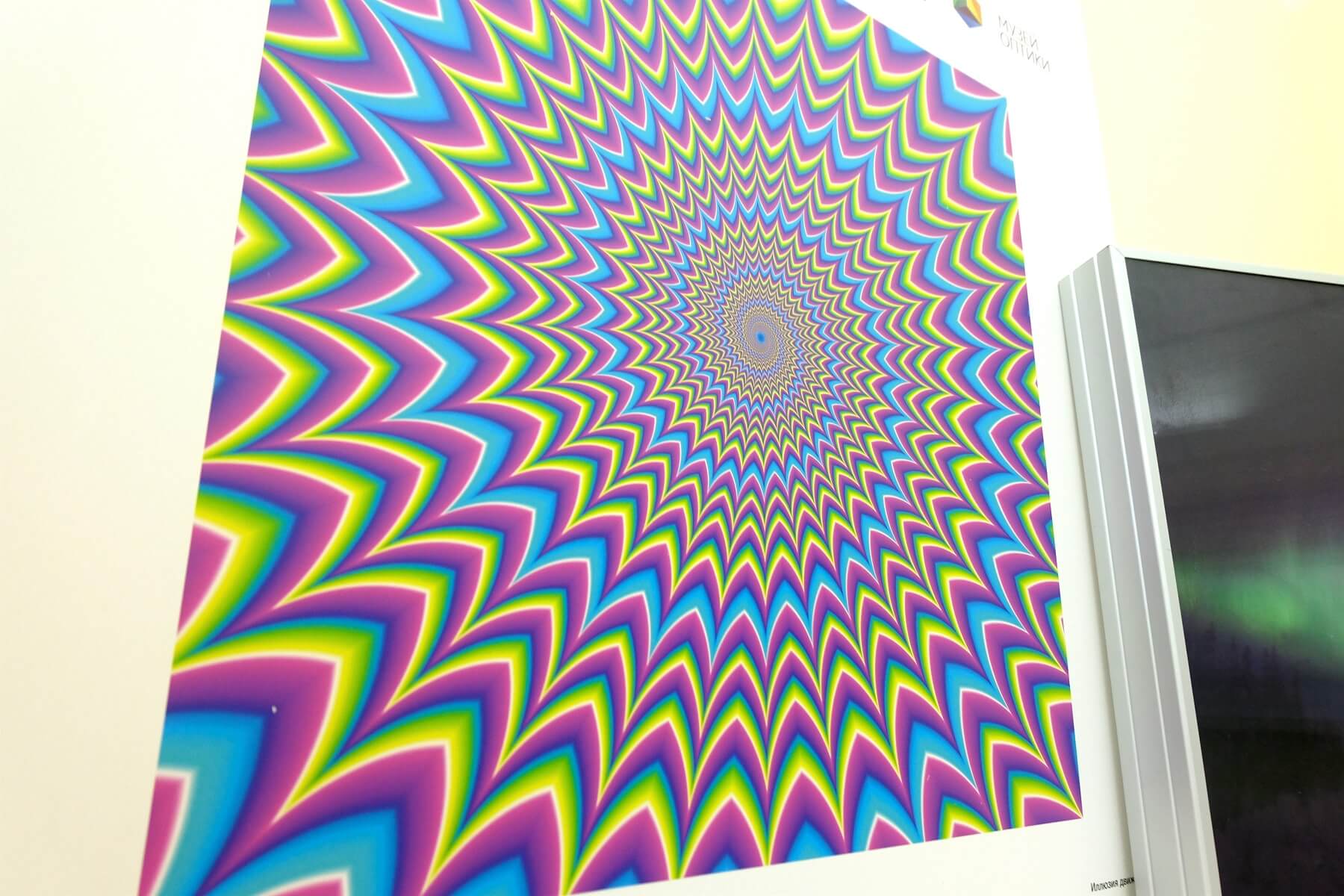
Pictured: Optical illusion
Modern 3D cinema is rooted in the 19th century - a stereoscope with pre-revolutionary cards helps to make sure of this. There is also a 3D-screen, for viewing the image on which no special glasses are required.

In the photo: a vintage stereoscope of 1901
In the exhibition hall there is a table with stationery rulers and other transparent objects. If you look at them through special filters, they will bloom with all the colors of the rainbow. This phenomenon is called photoelasticity .
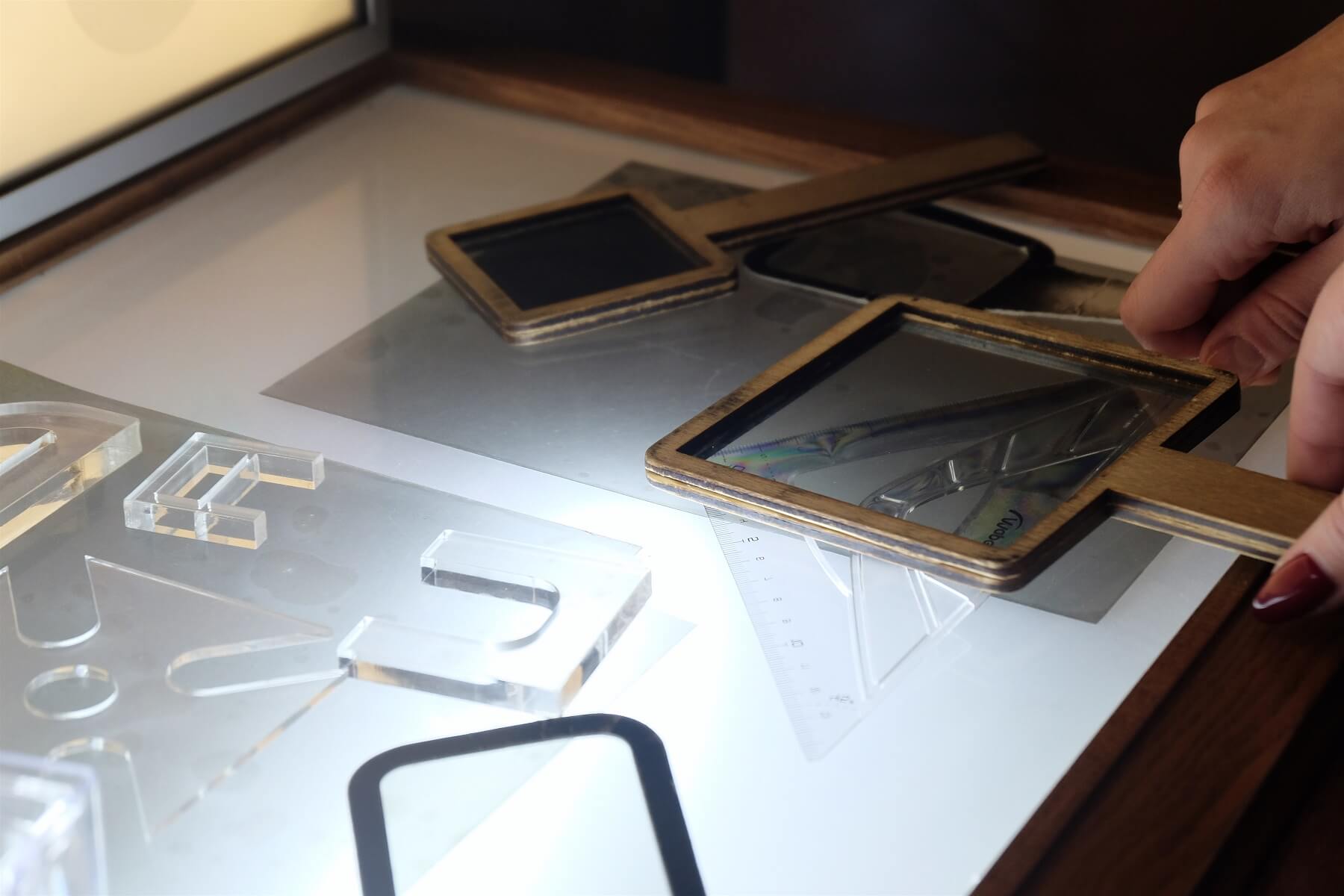
This is an effect when, under the influence of mechanical stresses, the body acquires double refraction (due to different refractive indices for light). Therefore, there are rainbow patterns. By this way, by the way, they check the loads in the construction of bridges and implants.
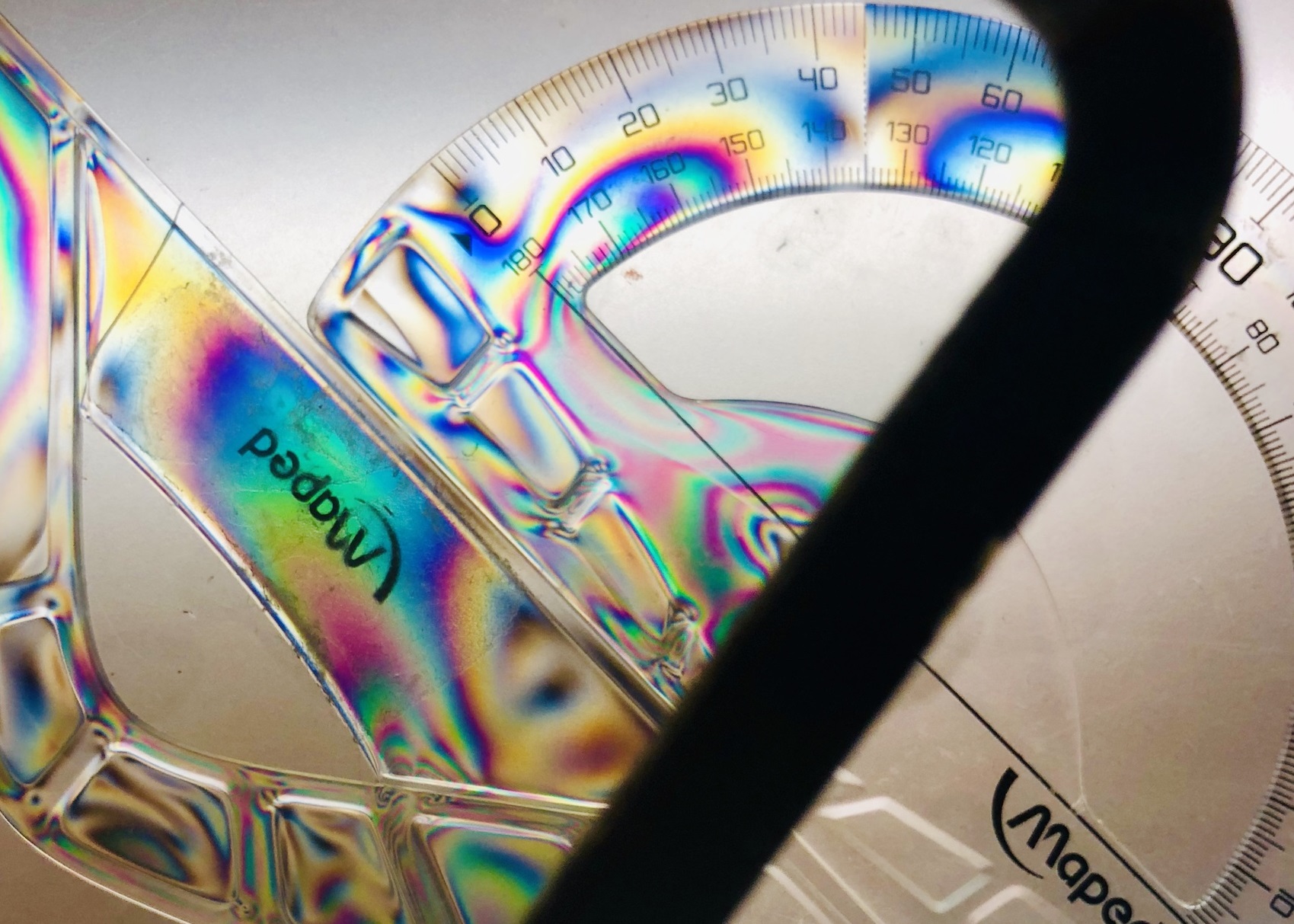
In the photo below - another white glowing screen. If you look at it through special filters, an image of a colored dragon will appear on it.
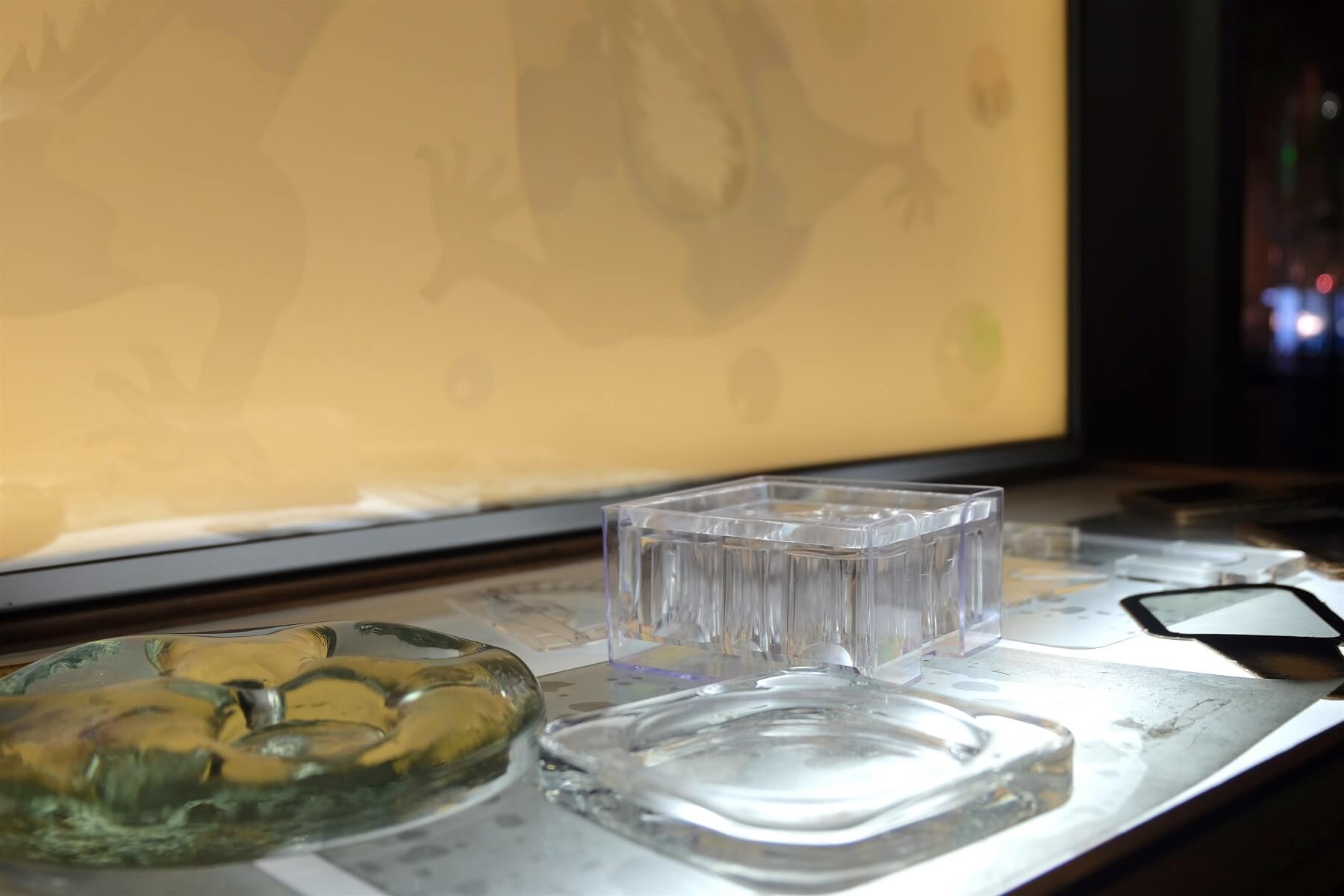
ITMO University often implements joint projects with artists who exhibit their work in a museum. For example, in one of the interactive halls, the LED installation “ Wave ” (Wave) is installed - the result of the “collaboration” of the university specialists and the Sonicology project team. The ideologist of the project was the media artist and composer Taras Mashtalir.
The Wave art object is a two-meter sculpture that, using motion sensors, "reads" the behavior of the audience and generates light and musical reactions.
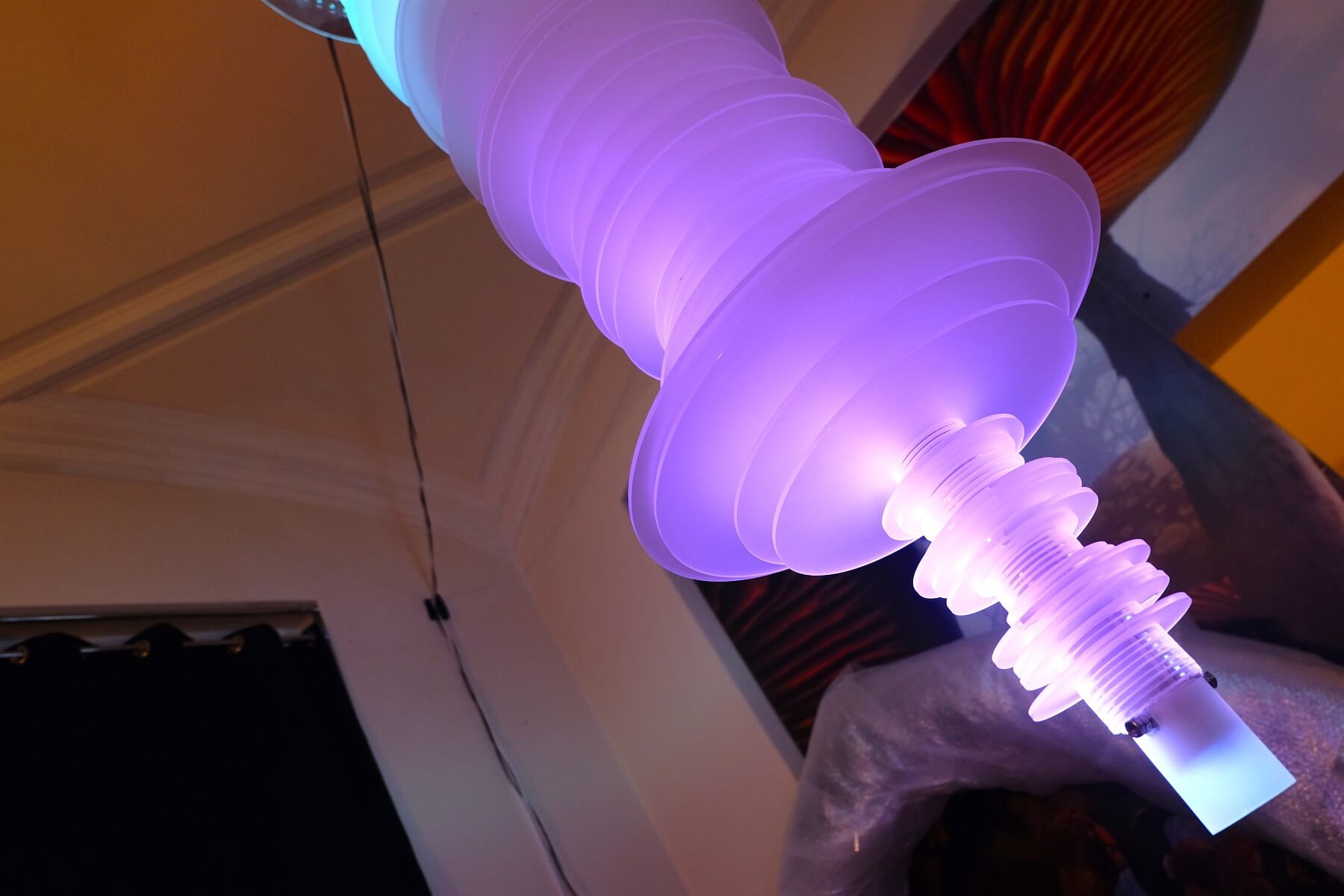
Photo: Wave LED installation
In the next exhibition hall mirror illusions are collected. Anamorphosis "decode" strange images and turn them into understandable images.
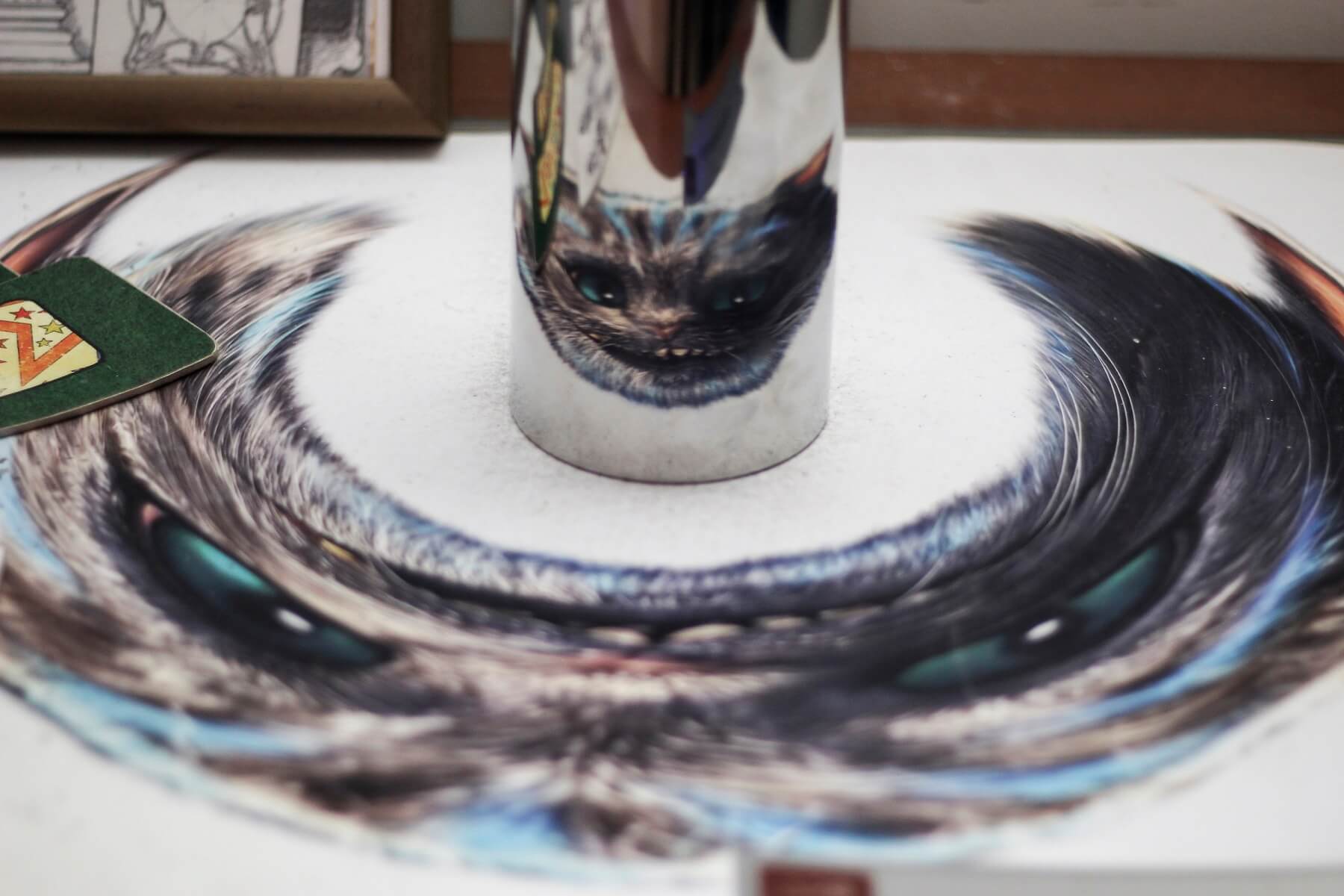
Next comes a dark room in which there are plasma lamps. You can touch them.
On the wall to the right of the lamps, you can paint with a flashlight, a special coating is applied on it. A wall on the contrary, the light does not absorb, but reflects. If you take a picture on her background with a flash - then on the camera screen we get only a shadow.

The penultimate hall of the exhibition is the ultraviolet room. It is dark and filled with a large number of luminescent objects. For example, there is a “glowing” map of Russia.
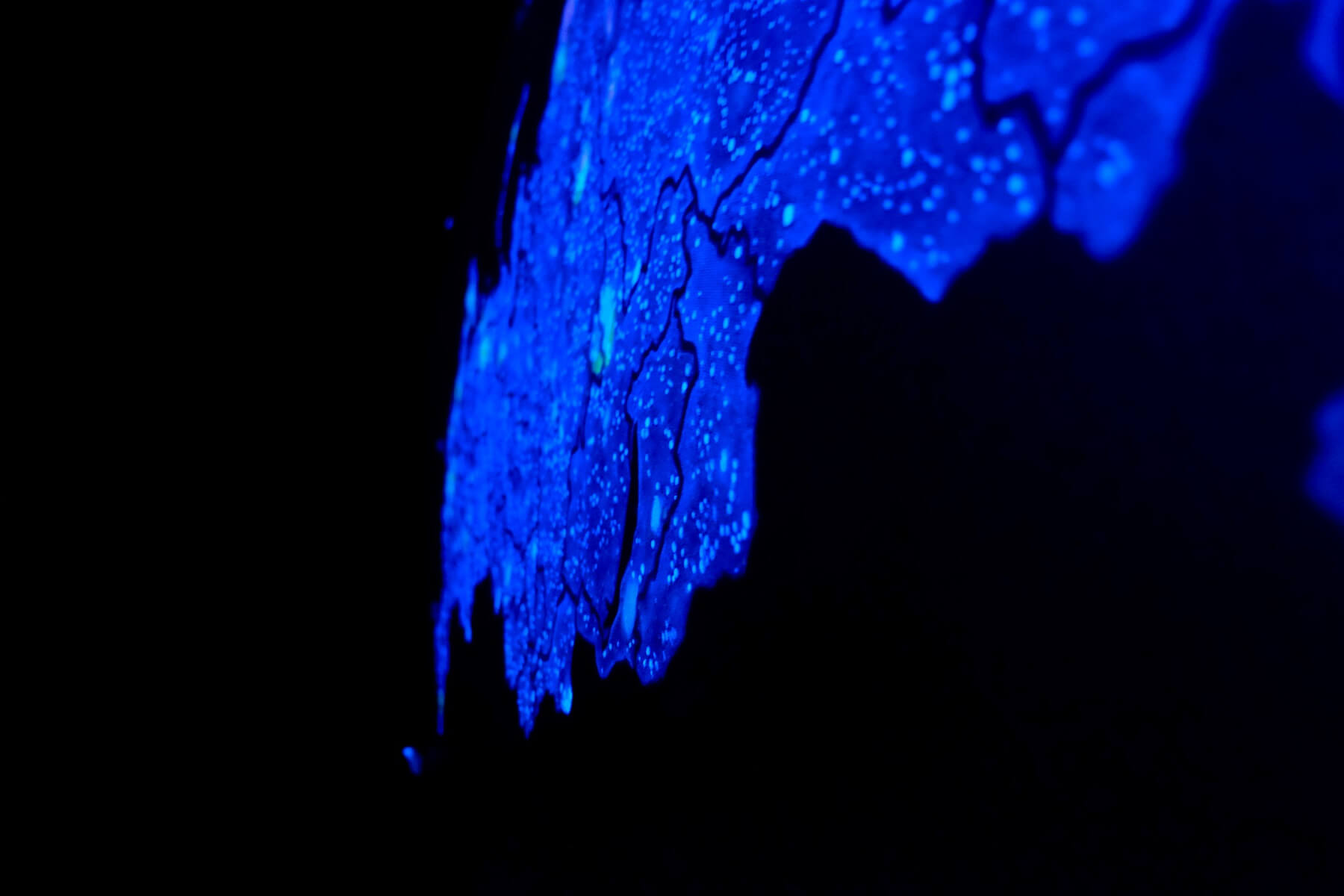
In the photo: Map of Russia, painted with fluorescent colors
The last exhibit is the Magic Forest. This is a mirror room with luminescent threads.
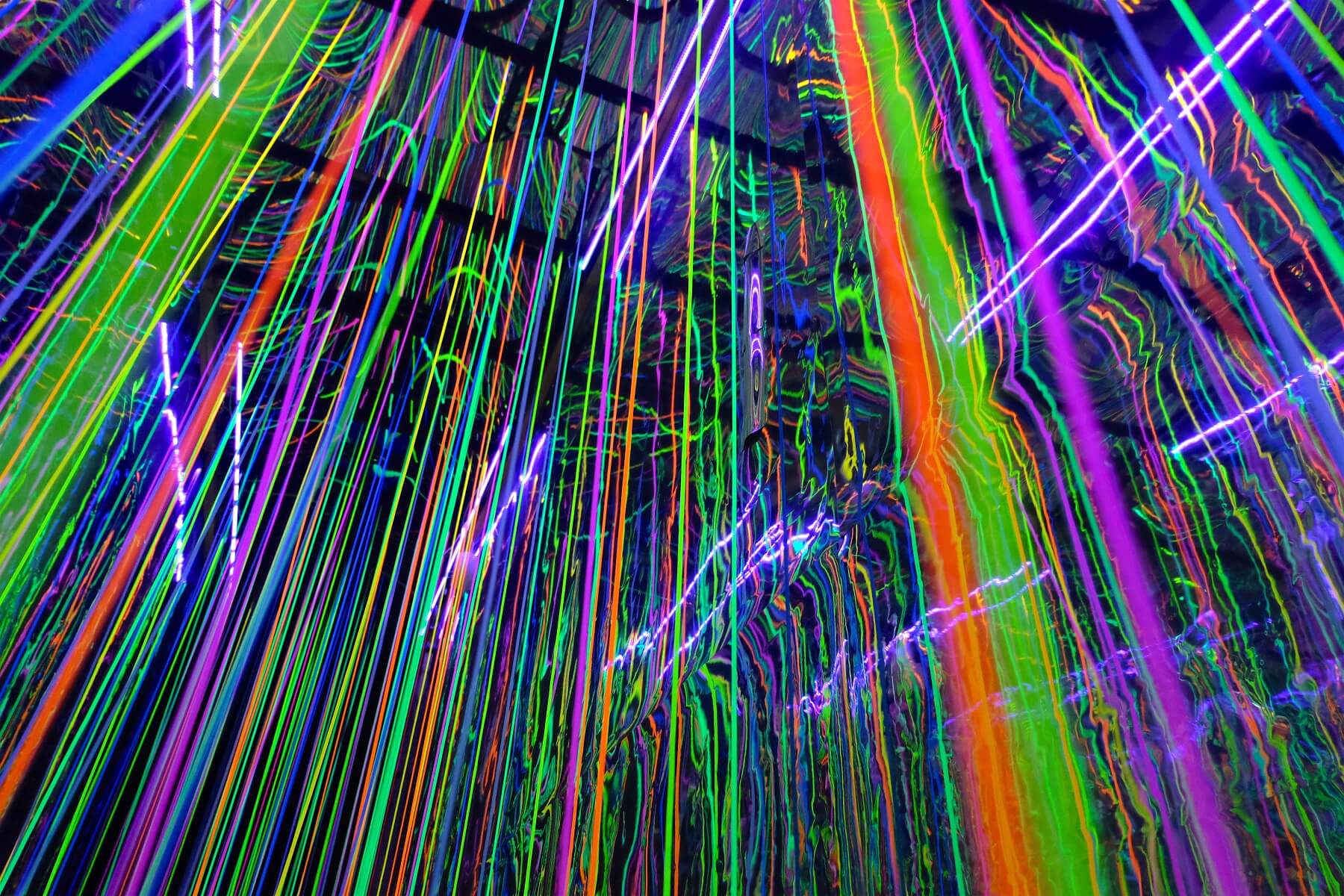
In the photo: "Magic Forest"

Every day, museum staff working on new exhibits and improve existing ones. Tours begin every twenty minutes. A series of master classes for schoolchildren also makes it possible to master a school course in optics in a fascinating and understandable format.
In the future, we plan to increase the number of interactive art objects in the museum, as well as conduct more lectures and workshops on its basis. A VR zone will appear here with the development of the Video 360 project of the ITMO University.
We hope that there will be more such interactive and educational projects, and the Museum of Optics of ITMO University will become an exhibition center for media artists from around the world.

Other articles from our blog on Habré:
Note: under the cut a lot of photos.

')
The museum was not immediately built
The Museum of Optics is the first interactive museum on the basis of ITMO University . It is located in a building on Vasilyevsky Island, where the State Optical Institute was previously located. The history of the museum dates back to 2007, when there was a restoration of buildings on the Exchange Line. Before the staff of the university there was a question: what to place in the premises on the first floors.
At that time, the direction of edutainment was developing and Sergey Stafeev , a professor of the Faculty of Physics and Technology, suggested that the rector Vladimir Vasilyev create an exhibition that would show the children that optics are interesting. Initially, the museum helped the University to solve the issue of vocational guidance and attracted students to specialized faculties. At first, only group excursions were arranged by appointment, mainly for grades 8-11.
Later, the museum team decided to organize a large popular science exhibition Magic of Light for everyone. It was first opened in 2015 on an area of more than a thousand square meters. meters
Museum exposition: informative and historical
The first part of the exhibition introduces visitors to the history of optics and talks about the development of modern holographic technologies. Holography is a technology that allows to reproduce three-dimensional images of various objects. At the exhibition you can watch a short informative film about the physical essence of the phenomenon.
The first thing that visitors see is the two tables on which the layouts of the hologram recording scheme are located. As examples, a miniature of the monument to Peter I on a horse and a nested doll are chosen.

With a green laser - a classic recording of Leith and Upatnieks , with which scientists obtained the first transmissive volume hologram in 1962.
With a red laser - the scheme of the Russian scientist Yuriy Nikolaevich Denisyuk. No laser is required to view such holograms. They are visible in the usual white light. The holographic part is devoted to a significant part of the exhibition. After all, it was in this building that Yu. N. Denisyuk made his discovery and assembled his first installation for recording holograms.


Today, the Denisyuk scheme is used throughout the world. With its help, analog holograms are recorded that are indistinguishable from real objects - “opto-clones”. Boxes with holograms of the famous Easter eggs of Carl Faberge and the treasures of the Diamond Fund are installed in the first hall of the museum.

In the photo: holographic copies of “ Ruby Caesar ”, “ Sign of the Order of Saint. Alexander Nevsky "and decoration" Bow-Square "
In addition to analog, in our museum there are digital holograms. They are created using 3D-modeling and laser technology. From a photograph of an object or video (which can be taken with the help of drones) on a computer, its model is being worked out. Then, it is recalculated into the interference pattern and transferred to the polymer film using a laser.
Such holograms are printed with the help of special holoprinters using lasers of blue, red and green colors (there is a little about their work in this short video ).
Among the digital holograms of the museum, created by a team of the University, there are models of the Alexander Nevsky Monastery and the Naval Cathedral in Kronstadt.
Still digital holograms are four-angle - they consist of four different pictures. If you go around such a hologram around, the images will begin to change.

So far, this method of recording holograms has not found wide application because of the cost of equipment for printing. There are no holo printers in Russia, so our Museum contains holograms of American and Latvian origin, for example, the map of Mount Athos.

Photo: Map of Mount Athos.
The second hall of the museum is also partially devoted to holography. Its general view is in the photo below.

In the photo: Hall with holograms
In this hall is presented the “holographic portrait” of Alexander Sergeevich Pushkin. This is one of the largest holograms on glass, and in scale it is the leader among analog holograms.
There is also a stand with a holographic portrait of Yu.N. Denisyuk with a story about the life of a scientist and his discovery. There is a hologram with footage of the poster for the film “I-Legend”.

Holograms of objects from various museums of the world, for example Hotei from the Russian Museum of Ethnography, are installed in this hall.

To the left of Pushkin's bust there is a lamp placed in a transparent case. Although the lamp this exhibit seems only at first glance. Inside it is an impeller with white and black blades. If you turn on the spotlight and shine on the impeller, it will begin to rotate.
The exhibit is called the Croix Radiometer.

Each of the four blades has a dark and light side. Dark - heats up more than light (due to the nature of light absorption). Therefore, the molecules of the gas in the flask, bounce off the dark side of the blade with greater speed than from the light. Because of this, the blade, turned to the light source by the dark side, receives a greater impetus.
The second part of the hall is devoted to the history of optics: the development of photography and the invention of glasses, the history of the appearance of mirrors and lamps.

On the stands you can find a large variety of optical devices: microscopes, " reading stones ", vintage cameras and vintage glasses. During the tour you can find out the history of the appearance of the first obsidian mirrors, bronze and, finally, glass. In the showcase presents the present Venetian convex mirror, created by the technology of the XVII century. And the bronze “magic mirror” (if you direct it to the sun, and the reflected “bunny” to the white wall, then an image will appear on it from the back side of the mirror).

In the same room is a collection of cameras. The exposition makes it possible to follow their development from the camera obscura - the progenitor of the camera - to the present.

In the photo: a collection of cameras
On the windows were placed cameras with folding fur and copies of the Pontiac MFAP, produced from 1941 to 1948, and AGFA BILLY from 1928. Among the presented devices one can find “ Fotokor ” - the first Soviet high-volume camera, created on the basis of the most successful Western samples. In the USSR, it was produced until 1941.

In the photo: Foldable camera " Fotokor "
If you go to the next hall of the museum, you can see a monumental light organ in it. The “tool” consists of 144 special optical glasses of different grades and brands - the Abbe catalog . There is no collection of similar size in the glass blocks and completeness of the collection anywhere in the world. She began to collect in the USSR, in order to perpetuate the achievement of scientists of the State Optical Institute, who developed the technology of production of radiation-resistant glass.

Now under each bar of glass is a LED ruler. These lines are controlled by controllers and a hub connected to a personal computer. If you play a melody on a PC, the organ will begin to flicker in different colors depending on the tone and pitch. The program has eight algorithms for converting sound to color. You can rate the system in this video on YouTube .
Exposure continued: interactive part
After the collection of optical glass should be the second part of the exposure - interactive. Most of the exhibits here can and should be touched. The interactive part begins with a study of the history of cinema and 3D-vision.
Zootropes , phenakisciscopes , phonotropes give an idea of how scientists studied the mechanisms of vision and information processing. You can see an example of a phonotorop in the photo below. The principle of operation is based on the inertia of vision. What we do not see with the eye, as the picture is smeared, is clearly visible through the camera of the smartphone.

In the photo: phonotrope - a modern analogue of zootrop

Pictured: Optical illusion
Modern 3D cinema is rooted in the 19th century - a stereoscope with pre-revolutionary cards helps to make sure of this. There is also a 3D-screen, for viewing the image on which no special glasses are required.

In the photo: a vintage stereoscope of 1901
In the exhibition hall there is a table with stationery rulers and other transparent objects. If you look at them through special filters, they will bloom with all the colors of the rainbow. This phenomenon is called photoelasticity .

This is an effect when, under the influence of mechanical stresses, the body acquires double refraction (due to different refractive indices for light). Therefore, there are rainbow patterns. By this way, by the way, they check the loads in the construction of bridges and implants.

In the photo below - another white glowing screen. If you look at it through special filters, an image of a colored dragon will appear on it.

ITMO University often implements joint projects with artists who exhibit their work in a museum. For example, in one of the interactive halls, the LED installation “ Wave ” (Wave) is installed - the result of the “collaboration” of the university specialists and the Sonicology project team. The ideologist of the project was the media artist and composer Taras Mashtalir.
The Wave art object is a two-meter sculpture that, using motion sensors, "reads" the behavior of the audience and generates light and musical reactions.

Photo: Wave LED installation
In the next exhibition hall mirror illusions are collected. Anamorphosis "decode" strange images and turn them into understandable images.

Next comes a dark room in which there are plasma lamps. You can touch them.
On the wall to the right of the lamps, you can paint with a flashlight, a special coating is applied on it. A wall on the contrary, the light does not absorb, but reflects. If you take a picture on her background with a flash - then on the camera screen we get only a shadow.

The penultimate hall of the exhibition is the ultraviolet room. It is dark and filled with a large number of luminescent objects. For example, there is a “glowing” map of Russia.

In the photo: Map of Russia, painted with fluorescent colors
The last exhibit is the Magic Forest. This is a mirror room with luminescent threads.

In the photo: "Magic Forest"

"To infinity and beyond"
Every day, museum staff working on new exhibits and improve existing ones. Tours begin every twenty minutes. A series of master classes for schoolchildren also makes it possible to master a school course in optics in a fascinating and understandable format.
In the future, we plan to increase the number of interactive art objects in the museum, as well as conduct more lectures and workshops on its basis. A VR zone will appear here with the development of the Video 360 project of the ITMO University.
We hope that there will be more such interactive and educational projects, and the Museum of Optics of ITMO University will become an exhibition center for media artists from around the world.

Other articles from our blog on Habré:
Source: https://habr.com/ru/post/459800/
All Articles